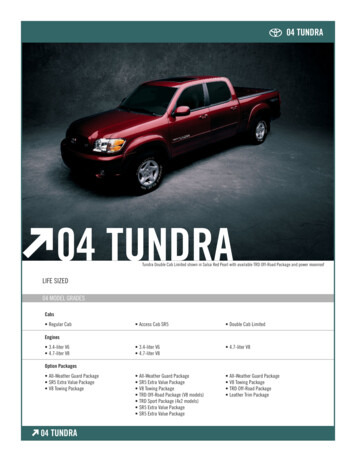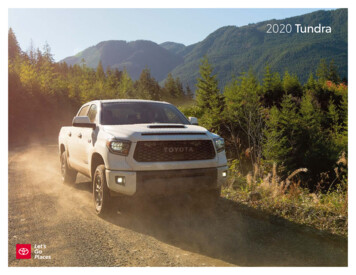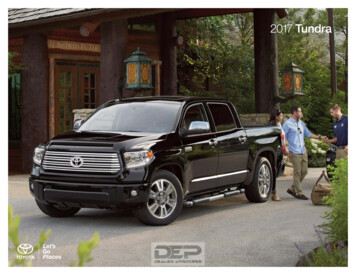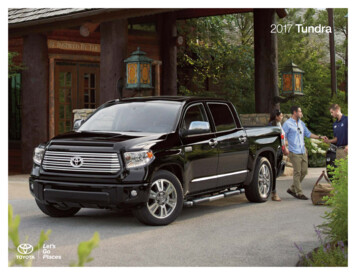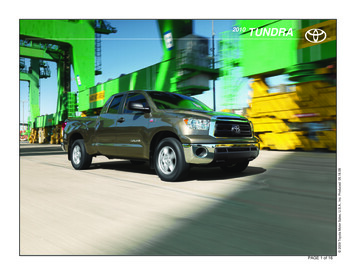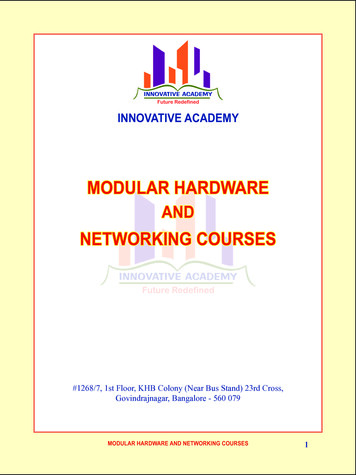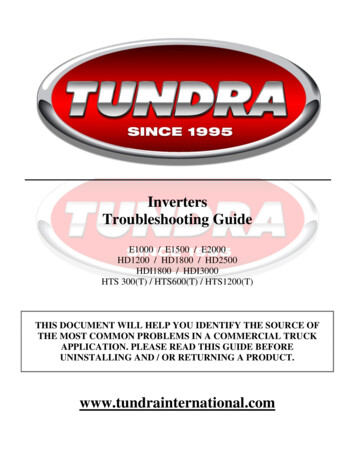
Transcription
InvertersTroubleshooting GuideE1000 / E1500 / E2000HD1200 / HD1800 / HD2500HDI1800 / HDI3000HTS 300(T) / HTS600(T) / HTS1200(T)THIS DOCUMENT WILL HELP YOU IDENTIFY THE SOURCE OFTHE MOST COMMON PROBLEMS IN A COMMERCIAL TRUCKAPPLICATION. PLEASE READ THIS GUIDE BEFOREUNINSTALLING AND / OR RETURNING A PRODUCT.www.tundrainternational.com
INTRODUCTIONThis document will help you identify the source of the most common problems in a commercial truck application. Please read thisguide before uninstalling and / or returning a product. This will help you identify, understand and solve 99% of the problems youmight be facing. If, after reading this document, you are still unable to solve the problem or if you encounter a problem that is notdescribed in this guide, please call your dealer or our online customer support at 1-877-964-2582 with the hereunder listedinformation ready. This will help our distributors and/or customer support representatives give you a quick and quality service:1. Model3. Purchase date2. Serial number4. Fault codes (if available)TUNDRA INTERNATIONAL INC. warrants its Power Inverters against defects in material or workmanship for a period of one(1) year from the date of purchase. This warranty applies only to the original purchaser (end-user) of the product. All defectiveproducts must be returned to an authorized dealer for a warranty claim. Returned units will then be evaluated by our technicaldepartment where a decision will be made as to whether the unit is covered by the warranty and will be repaired, credited or sentto a recycling plant.In order for the warranty to be validTHE FOLLOWING CRITERIA MUST BE MET:A.B.C.You certify that you have read and understood the related troubleshooting guide andto your knowledge, the origin of the problem is not your vehicle or the installation.The product has never been abused or modified.The product has never been exposed to liquids, heavy dust or corrosive material.IMPORTANT NOTECharges may apply if the unit is returnedin good working order or if the nature of the anomalyis related to the installation, the vehicle or its maintenance2I-TSG-0512-EN
FAULT CODESFrom the front panel of the Power Inverter (all models)Visual IndicatorsBlinking Green lightwith intermittent alarmBlinking Orange lightwith constant alarmPotential Problem(s) Low voltage condition Low voltage shut down High voltage shut down Overload shut downFrom the Power Inverter remote control (models equipped with digital remote only)Visual IndicatorsSolid Red Fault lightLUP (stands for LVP)OLPNote: The Overload protection as veryPotential Problem(s) Low voltage shut downHigh voltage shut downOverload shut downLow voltage shutdownOverload shutdownlittle reaction time and usuallycomes ON instantaneously.COMMON PROBLEMS & CAUSESBefore coming to the conclusion that your power inverter is not working properly, we recommend you read this section whichrefers to the most common causes of malfunctioning of a power inverter in a commercial truck application.1.2.3.4.5.6.1Improper installationLow Voltage protectionReverse polarityImproper maintenanceBattery problemsCharging problems7.8.9.10.11.Noise in audio / video equipmentImproper output voltageImproper Sine WaveOverload protectionHigh input voltage protectionMOST COMMON PROBLEMSCOMMON CAUSESConstant / intermittent alarmLack of output power / Poor performancesAutomatic shut offNot powering "on"Unable to power a specific load 4-5-10-111-4-5-8-9IMPROPER INSTALLATIONAn improper installation is the most common cause of failure / malfunctioning of a power inverter. Here is a simple wayto identify whether the installation is undersized, poorly made or if it requires maintenance: If a small load (i.e. 100W) can be supplied properly but a greater one (i.e. 1000W) is placingthe inverter on a Low Voltage Protection (LVP) state, the installation is probably at cause.3I-TSG-0512-EN
The use of our CM Series Installation Kits is strongly recommended but not obligatory. However, it is crucial tocarefully follow the material and methodology recommendations found in the user manual of your inverter. Failure to doso could cause operational problems and potentially cause an incident leading to equipment loss or personal injury.INSTALLATION FUNDAMENTALSA.B.C.D.E.2Always follow the user manual recommendations.Select the appropriate cable type & gauge.Select the appropriate in-line fuse.Proceed to an adequate crimping and color coding of all terminals.NEVER UNDERESTIMATE THE CONSEQUENCES OF A BAD INSTALLATION.LOW VOLTAGE PROTECTIONAll Tundra Power Inverters are software controlled and equipped with a Low Battery Protection that prevents drainingthe batteries below a predetermined level. The Low Voltage Protection (LVP) set-up may vary from one model toanother. You may refer to the user manual or specs of your inverter for more details.Low-end Power Inverters and none truck specific ones generally allow a very deep discharge of the batteries ( 8 to 10Volts). These are therefore putting at risk the engine starting as well as the batteries’ and alternators’ lifespan. Tundra“Truck Approved “ Series Power Inverters have a special programming informing you that the capacity of your batteriesis decreasing and that it is time to recharge them. Although the reaching of this alarm can be gradual, it can also beinstantaneous if you attempt to power a substantial load. The remote remains the best tool to asses and understand what isgoing on.TUNDRA PROGRAMMING FUNDAMENTALS3Tundra "Truck Approved" seriesOther Tundra seriesLow battery voltage alarm at 11.5 VoltsLow battery voltage shutdown at 11.0 voltsNo tolerances on these parametersLow battery voltage alarm at 10.5 VoltsLow battery voltage shutdown at 10.0 voltsNo tolerances on these parametersREVERSE POLARITYReversing the polarity of the cables when installing or doing the maintenance of a Power Inverter is not unusual. Thisproblem typically occurs during the initial installation because the installer failed to color code each cable using heatshrink tubing or simply by lack of attention during a regular maintenance [-]Black & [ ] Red. Although this is notcovered by the warranty, Tundra inverters distinctive and innovative design, are generally serviceable when this happens.To do so, you must carefully follow the following instructions:REVERSE POLARITY FUNDAMENTALSA.B.C.YOU MUST completely disconnect the inverter from the batteries.YOU MUST remove the inverter from the vehicle.Carefully remove the top cover (see hereunder illustrations).4I-TSG-0512-EN
E & HTS Series Remove the 2 upper screws on the front panel and the 2 upperscrews on the rear panel only (total 4).HD & HDI Series Remove 4 top screws / 4 left screws / 4 right screws (12 total) only.D.Evaluate ALL the ATO fuses using a multi-meter on diode mode.E & HTS Series 8 fuses located F1 to F8 on the PCB5I-TSG-0512-EN
HD & HDI Series 12 fuses located F1 to F12 on the PCBE.Replace all ATO fuses (only if all burned) by gently removing them out of their socket. Oncereplaced and before trying to restart the inverter, you MUST place the cover back and re-installthe Power Inverter (refer to user guide for installation recommendations).WARNINGS !I.IF and ONLY IF, all ATO fuses are burned; you can replace them all using the same type and amperage fuses inorder to bring the Power Inverter back to service. If only one or few of the ATO fuses are burned; this indicates amajor failure and therefore not repairable on site. Ignoring this advice and replacing some fuses can lead to a fireand personal injury.II.Replace fuses using identical fuses (same type and same capacity). Replacing the fuses with a different capacitycan lead to a fire and personal injuries.III.DO NOT attempt to repair and / or replace any other components on the printed circuit board. This can lead to afire and personal injuries.4IMPROPER MAINTENANCEThe maintenance of a Power Inverter is often overlooked. Over time, the various electrical connections (on batteries, fuseblock and Power Inverter’s ends) tend to loosen, corrode and lose their effectiveness. In the past, signs of corrosion wereeasily detected on the copper connectors. Today, tinned or plated connectors (grey) are less prone to corrosion, but arestill subject to a chemical reaction producing a gum which may prevent the free flow of electric current between theconnectors or terminals. It is indispensable to clean all the terminals in the battery box (including the fuse) and PowerInverter connections, at least every six months.MAINTENANCE FUNDAMENTALSUSING A WIRE BRUSH AND A GREASE DISSOLVENT AGENT:A.All battery terminals and lugs must be cleaned every 6 months.B.Fuse & fuse holder terminals and lugs must be cleaned every 6 months.C.A protective sealant which "dries like paint" must be used on all battery terminalsafter cleaning/maintenance.WARNINGS !I.Grease-based protective coating or those which remain humid (sticky) should be avoided at all times. They tendsto attract contaminants (i.e.: dust) therefore promoting a faster destruction of the connections. Additionally, the6I-TSG-0512-EN
formation of debris on the terminals will prevent you from seeing the state of your connections during a visualinspection.II.5The accumulation of contaminants on the batteries can cause a continuity between the battery poles being at theorigin of a constant cycling of your batteries thus reducing their lifespan and causing additional maintenance costsand downtimes.BATTERY PROBLEMSTo supply a Power Inverter with the voltage and amperage it needs, batteries must be in good condition and fully charged.In the event where a Tundra Power Inverter would prematurely shut down, the batteries condition must be evaluated. Todo this, you must follow the following steps:BATTERY PROBLEMS FUNDAMENTALSA. Properly recharge the batteries using a low amperage charger. Tundra IBC seriesBattery Chargers are among the best options.B. Perform a load test using a quality AVR device designed for this purpose.C. Never replace only one battery on a battery bank. Preferably replace them all at once.If not possible, find a “tested good” used battery.D. If the problem is not the batteries, then the alternator or its capacity should beevaluated. See next topic for more details.WARNINGS !I.6Combining new batteries with older ones will promote a rapid deterioration of the most recent / better batteries.CHARGING PROBLEMSCharging problems are frequent. If your vehicle is equipped with an alternator of less than 160A, the batteries are perhapsnot fully charged, even if the vehicle has traveled for more than eight consecutive hours. Indeed, in some cases, theconsumption is greater than the alternator’s charging capacity. This condition happens mainly in winter and/or at night,when the different electrical systems are highly solicited. If the batteries are in a discharge state and the alternator isworking fine after testing its output capacity, you should consider replacing the vehicle’s alternator with a more powerfulone.CHARGING FUNDAMENTALSA. An alternator should always be tested using a quality AVR.B. The maximum "continuous" amperage required by a truck should never exceed 75% of themaximum capacity of an alternator.WARNINGS !I. If you replace the alternator by a more powerful one, you should plan to replace the alternator output cable by aheavier gauge.7NOISE IN AUDIO / VIDEO EQUIPMENTSome CB radio, stereo systems or televisions may under certain circumstances emit a buzzing sound or show a pixelizedimage called “noise”. These devices have been designed to catch surrounding signals to function properly. Among the7I-TSG-0512-EN
available signals, it is common that they also catch inappropriate ones such as the magnetic field generated by analternator or a rotary apparatus (fridge compressor - fan, etc.).If more than one of these accessories are powered through the same Power Inverter, the phenomenon can be accentuated.Our inverters are designed to minimize as much as possible this kind of inconvenience. If you experience some of thesaid troubles, very few solutions exist other than;A. Reviewing the installation in order to make sure that both DC cables from the batteries to the inverter are"joined" all the way.B. Managing your way of working with the inverter differently, and stop using rotary apparatus and audioequipment at the same time.8IMPROPER OUTPUT VOLTAGETo read a Modified Sine Wave, you must use a True RMS multi-meter. It is common to find multi-meters (thoughexpensive) which are unable to read a Modified Sine Wave. With such multi-meter, the output power readings couldrange between 96 and 140V, which is incorrect. Keep in mind that the value of the equipment (multi-meter) you are usingdoes not reflect the fact that it is True RMS or not. If you need to test the output power of your inverter (using a TrueRMS multi-meter), remember that our Power Inverters are designed to produce an output voltage that ranges from 115 to125V.9IMPROPER SINE WAVE (Modified Sine Wave ONLY)If your load (accessory) runs great on a conventional electrical outlet (i.e.: at home) but not through your Power Inverter,its incompatibility to a Modified Sine Wave may be the cause. If no other problem source has been found after goingthrough this document and the trouble persists, the use of a PURE Sine Wave Power Inverter will most likely be required.SINE WAVE FUNDAMENTALSA.Our Modified Sine Wave power inverters are engineered to offer you the very best ModifiedSine Wave possible thus virtually offering no restrictions. You can run Microwaves, coffeemakers, toasters, LCD TVs, laptops, battery chargers and much more with confidence.WARNINGS !I. Regardless the quality of the Modified Sine Wave Power Inverter you are using, some very sensitive devices such asmedical equipments (i.e.: CPAP machines) must run from a Pure Sine Wave ONLY. Otherwise, these may besuffering of an erratic functioning (if running at all) and their lifespan could be shortened as well.10OVERLOAD PROTECTION (Load higher than inverter nominal capacity)Heavy loads can give the impression that they are small because they are commonly used in residential or commercialapplications (i.e.: Microwaves, coffee makers, bar fridges, vacuum cleaner, etc). The ability to provide a peak powercapable of starting a demanding load is much lower on a Power Inverter than on a conventional power source (residential/ commercial) supplied by the public services.Heavy loads like a circular saw or a compressor may require a larger capacity Power Inverter as well as more batterycapacity than you currently have. In the event that a load would be impossible to operate with your existing configuration,please contact us for more information and recommendations.8I-TSG-0512-EN
11HIGH INPUT VOLTAGE PROTECTIONAll Tundra Power Inverters are software controlled and equipped with a High Input Voltage automatic shutdown thatprevents damaging the Power Inverter above a predetermined level. The High Voltage Protection set-up may vary fromone model to another. You may refer to the user manual or specs of your inverter for more details.Low-end Power Inverters and none truck specific ones generally allow a very high input voltage from alternators or shopchargers ( 16 to 18 Volts). These are therefore putting at risk the inverters lifespan. Tundra “Truck Approved" SeriesPower Inverters have a special programming that will instantaneously shut down the Power Inverter if it senses an inputvoltage higher than its initial programming. This function shows no alarm code and no automatic restart. The PowerInverter must be manually reset. If this condition is frequent, you must evaluate your alternator for a potentially "higher"than normal charging voltage.9I-TSG-0512-EN
5 I-TSG-0512-EN E & HTS Series Remove the 2 upper screws on the front panel and the 2 upper screws on the rear panel only (total 4). HD & HDI Series Remove 4 top screws / 4 left screws / 4 right screws (12 total) only. D. Evaluate ALL the ATO fuses using a multi-meter on diode mode.


